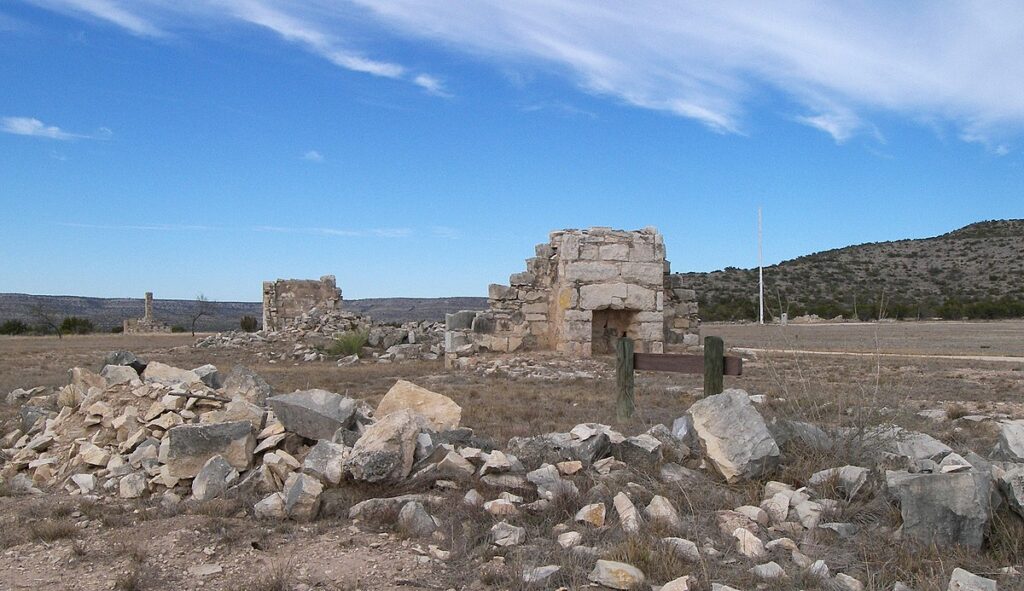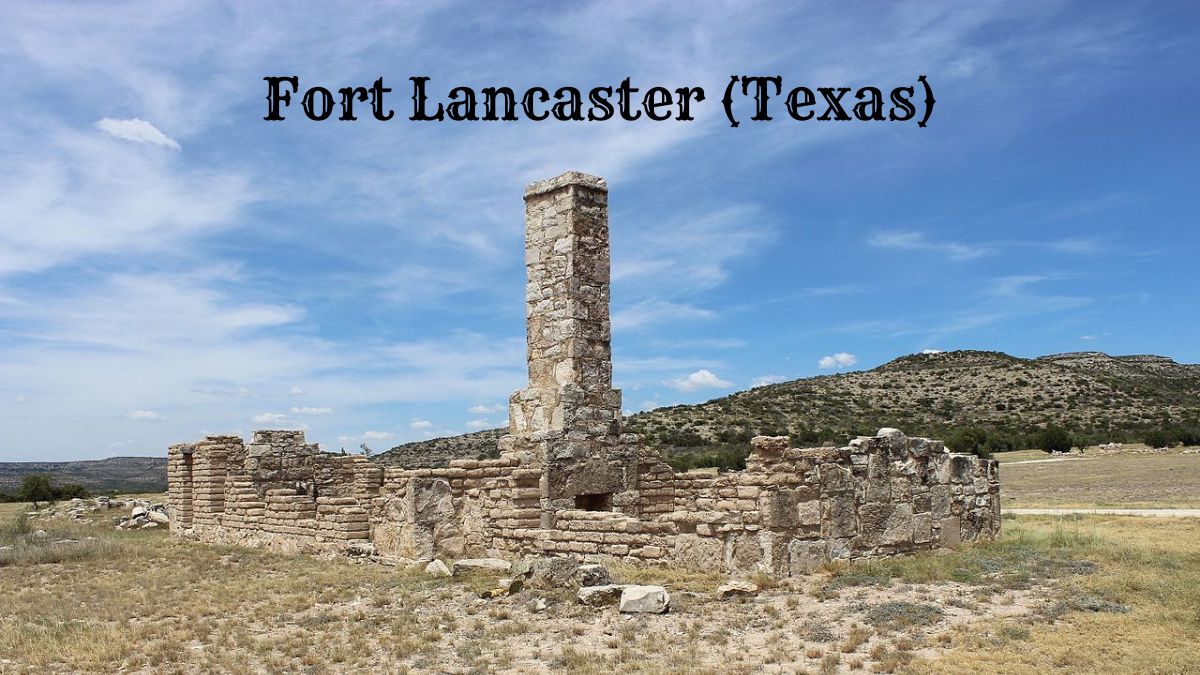Fort Lancaster, a crucial historical site in Texas, played a vital role in the 19th century by safeguarding the San Antonio–El Paso Military Road.
Established in 1855, it protected travelers from Native American raids and supported the growth of nearby settlements.
The fort’s strategic location near the Pecos River ensured essential resources for the troops. Today, visitors can explore the ruins and learn about the fort’s influence on westward expansion and military strategy.
Fort Lancaster offers a unique glimpse into the challenges and triumphs of frontier defense, highlighting an essential chapter in Texas’ past.
Overview of Fort Lancaster (Texas)

Fort Lancaster, a historic site in Texas, played a crucial role in the 19th century as a protector of the San Antonio–El Paso Military Road.
Historical Significance
Fort Lancaster was established in 1855 to protect travelers on the San Antonio–El Paso Road.
The fort housed several military units and defended against Native American raids. Significant battles and engagements at Fort Lancaster highlight its military importance in the region.
The fort’s role extended beyond military protection, contributing to the development and safety of the surrounding settlements.
The historical ruins and artifacts found at the site today offer a glimpse into the fort’s operational period and the challenges faced by its occupants.
Geographic Location
Fort Lancaster is located near the Pecos River in Crockett County, Texas. This strategic location provided a vital link between San Antonio and El Paso.
The fort’s proximity to the river ensured a steady water supply, essential for the troops and their animals.
The terrain around Fort Lancaster is characterized by rugged hills and expansive plains, typical of West Texas.
Key trails and access points from Fort Lancaster played a critical role in the logistics of the military road, facilitating the movement of goods and troops across the frontier.
Historical Context

Fort Lancaster, established in the mid-19th century, was crucial in defending settlers and travelers. Its history intersects with significant military engagements and its lasting state as a historic site.
Formation and Establishment
Fort Lancaster, located in Crockett County, Texas, was established in 1855 to protect travelers and settlers during the westward expansion.
It was part of a chain of forts to secure safer routes for stagecoach lines and mail services.
The fort was a strategic outpost against Native American attacks, with structures made of adobe and stone. It housed barracks, a commissary, and officers’ quarters.
Military Engagements and Conflicts
Throughout its active years, Fort Lancaster faced several military engagements. It witnessed action during the Civil War when Texas became a Confederate state.
The fort’s garrison played a role in confrontations with Union forces and Native American tribes.
One notable conflict was the 1867 Battle of Fort Lancaster, where the 9th Cavalry repelled an Apache attack. The fort’s presence helped stabilize the region, though it was eventually abandoned in 1869 as threats diminished.
Fort Lancaster State Historic Site
Fort Lancaster has been preserved as the Fort Lancaster State Historic Site. Visitors can explore the ruins of the original structures, including barracks and fortifications.
The site includes interpretive trails and a visitors’ center with exhibits detailing the fort’s history and significance.
The center educates the public about the challenges of westward expansion, military strategy, and daily life at the fort. The presence of restored ruins provides a tangible link to the past for educational and commemorative purposes.
Architectural Features of Fort Lancaster
Fort Lancaster boasts a mix of construction materials and structural layouts, which indicate the fort’s historical significance and architectural evolution.
Construction Materials and Techniques
The buildings at Fort Lancaster were constructed using materials like stone and adobe.
Limestone blocks were commonly employed for foundations and walls, offering durability and some insulation.
Adobe bricks, comprising straw and clay, were used for smaller, less permanent structures, showing adaptability to local resources.
Chimneys were often made from stone or brick, critical for ventilation and heating.
Using local materials, like limestone, reduced transport needs and integrated the fort into its environment. These techniques highlight practical approaches tailored to the region’s climate and resources.
Layout and Major Structures
The layout of Fort Lancaster includes distinct permanent buildings organized functionally.
The fort’s major structures consist of barracks, officers’ quarters, and storage buildings strategically placed for efficiency and defense.
Foundations of limestone blocks ensure structural stability, especially in key buildings like the barracks and officers’ quarters.
Public buildings, like the mess hall and commissary, were centrally located to serve the garrison effectively.
Chimneys in these structures ensured proper ventilation and warmth during cold periods.
These structures’ strategic placement and robust construction reflect thoughtful planning to enhance operational efficiency and comfort.
Inhabitants and Personnel
Fort Lancaster has experienced a mix of military and civilian occupations throughout its history. This balance significantly influenced the fort’s operations and daily life.
Military Presence and Units
The primary occupants of Fort Lancaster were military personnel. The U.S. Army stationed various units, including cavalry and infantry.
Notably, the Second Regiment of Texas Mounted Rifles played a crucial role.
Buffalo Soldiers, African-American troops in the U.S. Army, were also stationed here for a period. These soldiers contributed significantly to the defense and security of the area against various threats.
The fort’s location demanded a constant military presence due to conflicts with Native American tribes such as the Kickapoo, Comanche, and Apache.
Their roles included guarding supply routes and engaging in skirmishes with hostile forces to protect settlers and maintain order.
Civilian Involvement
Civilians, in addition to soldiers, were integral to Fort Lancaster. Civilians included traders, blacksmiths, and family members of military personnel.
Mexican traders often visited the fort, exchanging goods and supplies. This interaction was essential for maintaining the fort’s provisions and fostering relationships with nearby communities.
Women and children also lived at Fort Lancaster, contributing to a semblance of normalcy. They managed domestic tasks and supported morale.
These civilians’ presence highlighted the fort’s role as a military outpost and a community hub in a challenging frontier environment.
Natural Environment and Resources
Fort Lancaster has a diverse natural environment characterized by various plant and animal species and significant water resources.
Flora and Fauna
The area around Fort Lancaster is home to various plant and animal life.
Live oak trees and numerous grass species form the dominant vegetation. These grasses are crucial in the ecosystem, providing food and shelter for various animals.
Wildlife includes deer, rabbits, and numerous bird species. Reptiles, including lizards and snakes, are also common.
These animals contribute to the biodiversity and balance of the region’s natural environment.
Water Resources
Two key water sources near Fort Lancaster are the Pecos River and Live Oak Creek.
The Pecos River, flowing through the area, is vital for the region’s water supply, supporting wildlife and human needs.
On the other hand, Live Oak Creek provides a more localized water source.
Both bodies are essential for irrigation, drinking water, and maintaining the natural habitat. These resources are vital for sustaining the area’s flora and fauna.
Explore More: Army Forts in Texas
Cultural and Heritage Conservation
Efforts to preserve Fort Lancaster emphasize restoration, public education, and reassessment of its historical significance. Each initiative plays a vital role in maintaining the integrity and legacy of this Texan landmark.
Restoration Efforts
The Texas Historical Commission has collaborated with Texas Parks and Wildlife on restoration projects, including rebuilding structures and preserving artifacts found on site.
Authentic materials and historical techniques are employed to maintain historical accuracy.
Significant work has been done to stabilize the remaining ruins and prevent further degradation.
The National Register of Historic Places recognizes these efforts, ensuring protection and highlighting the fort’s value.
Public Engagement and Education
The Visitor Center and Museum offer comprehensive educational programs to raise public awareness.
Interactive exhibits illustrate the fort’s history and significance in broader Texan history.
Scheduled guided tours and school programs help engage visitors of all ages.
Public engagement initiatives become pivotal in its preservation by fostering a deep appreciation for Fort Lancaster’s contribution to Texas.
Historical Significance Reassessment
Reassessing Fort Lancaster’s historical significance involves continuous research and reevaluation of its historical role.
Archeologists and historians periodically review artifacts and records.
New findings are integrated into museum exhibits and educational materials.
These efforts help maintain an accurate, up-to-date portrayal of the site. Such reassessment honors the fort’s past and informs future conservation strategies.
Explore More: 10 Historic Forts in Texas: Exploring a Rich Military Heritage
Fort Lancaster’s Influence on History
Fort Lancaster played a vital role in the expansion and defense of the American Frontier.
Its influence on local communities and its connection to major historical events such as the California Gold Rush made it a significant landmark.
Relation to the American Frontier
Fort Lancaster marks a significant point in the history of the American Frontier. Established in 1855, it was a military outpost to protect settlers traveling the San Antonio-El Paso Road.
This road was a major route for those heading to California during the Gold Rush, offering protection and a logistical waypoint.
The fort provided security against Native American raids and facilitated safe passage for emigrants. Its strategic location underscored the military’s role in supporting westward expansion.
Impact on Local Communities
The establishment of Fort Lancaster had a profound effect on the surrounding rural communities in Texas. It provided employment opportunities and spurred economic activity.
Local businesses thrived by catering to the needs of soldiers and travelers alike. The fort’s necessity during colonization drew people to the area, leading to the development of infrastructure and localized growth.
By influencing settlement patterns and encouraging economic stability, Fort Lancaster contributed to the region’s development during a formative period in Texas history.

Cory is a website owner and content creator who enjoys fishing, history, coin collecting, and sports, among other hobbies. He is a husband and father of four.
Romans 15:4 For whatever was written in former days was written for our instruction, that through endurance and through the encouragement of the Scriptures we might have hope.

